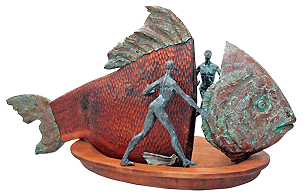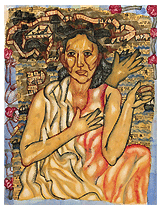- Prelude
- Editorial
- 'Public Sculptures are the Public's own Consciousness'
- Stimulating Thoughts
- Sculptural Traditions and Contemporary Art Practices
- Sculpting out a Third Dimension from Madhya Pradesh
- About Nostalgic Dragonflies and Homes in the Bags: Sculptural Snapshots from the North-East
- A Concise Chronicle of Bengal's Modern Sculpture
- Neo-sculptural Identity: Six Young Sculptors
- From Object to Experience: Notes on American Sculpture
- In the Domain of Drama Sculptures of S.Nandagopal
- Satish Gujral : Sculpting the Inner Form
- Transformation of Articulations: Mrinalini Mukherjee
- The Experiential Quotient in the Sculptures of Ravinder Reddy
- Shresta Rit Premnath A Passion for Structure
- The Anatomy of Melancholy: Sculptures of Rajesh P Subramanium
- A Crusader of/for Site Specific Public Art: Subodh Kerkar
- Installation Practices in and around Santiniketan
- A Wall is a Screen: A Promenade Film Street Performance
- Jaeger-LeCoultre An Overview
- Regency Style: Regency Furniture
- Designing the Streetscapes: Visual Elements of Pedestrian Corridors
- Sculpture Rules It All
- The Triumph of the Eternal
- Artist Index and Statistics- Anish Kapoor
- Auction Reports
- Musings from Chennai
- Art Bengaluru
- Art Events Kolkata: October-November 2010
- Mumbai Art Sighting
- An Evening of Interaction
- 6th Asian Museum Curators' Conference
- Swedish Art in India
- Couple of Difference : Recent sculptures of Karl Antao
- Previews
- In the News
- Sotheby's : Important Watches Geneva
ART news & views
Previews
Volume: 3 Issue No: 11 Month: 12 Year: 2010
Aakriti Art Gallery
Kolkata
Projection of Disjointed Times : Sculptures by Akhil Chandra Das
November 15 to December 31
 Akhil Chandra Das's sculpture embodies the interplay and paradox of illusion and reality. His sculptural artifices represent a disjointed time with its hypocrisy and erosion of values. The reality in his sculpture comes garbed in mythology and surrealism. His works of bronze and wood in “phantasmagoria” series improvise on and transmute the materiality of both the mediums which synchronise with an internal jarring effect.
Akhil Chandra Das's sculpture embodies the interplay and paradox of illusion and reality. His sculptural artifices represent a disjointed time with its hypocrisy and erosion of values. The reality in his sculpture comes garbed in mythology and surrealism. His works of bronze and wood in “phantasmagoria” series improvise on and transmute the materiality of both the mediums which synchronise with an internal jarring effect.
The pieces showcased in this exhibition show Das's stylistic range with the witty deployments of double entendre, and of mask forms dealing with humans and animals. Akhil himself has presented himself as a ludicrous, and a little loveable, totem absurdly keeping pace with a consumerist society and quirky time.
Jamaat National House
Mumbai
Ghadwakam Sculptures by Jaidev Baghel
November 17 to December 15
 Continuing with their commitment of showcasing masters of traditional sculpture, Jamaat will present Ghadwakam Sculptures by master sculptor Jaidev Baghel who hails from the Ghadwa family of the Bastar tribe in Chattisgarh.
Continuing with their commitment of showcasing masters of traditional sculpture, Jamaat will present Ghadwakam Sculptures by master sculptor Jaidev Baghel who hails from the Ghadwa family of the Bastar tribe in Chattisgarh.
Ghadwakam or lost wax metal casting is an ancient art of casting in India which retains delicacies of form, line and modulation of intricate design work. An intricate and elegantly carved statue of a dancing girl excavated in Mohenjodaro dated around the third millennium BC shows that the lost wax process was already perfected here.
This pre-historic technique still survives in Tribal art and is used for making religious icons, jewellery like anklets and necklaces, utility items like oil lamps, musical instruments, containers, measures, and ritualistic items like trees and animal forms.
The metal sculptors are called Ghadwas and are of the Bastar tribes living in the forests of Chattisgarh. An interesting characteristic of Bastar art is the elongated torsos and limbs of the stylised figures. Their craft includes sculptures of their own Gods and Goddesses like Raodev, Dhanteshwaridevi, Moulidevi and Pardesin Matadevi.
Seven Art Limited Gallery
New Delhi
Solo Exhibition of Vijai Patchineelam
November 18 to January 11
 With a view to stress the functional perspective of art and design Seven Art Gallery, New Delhi presents “the Guillotine Series” (from 18th Nov 2010 to 10th Jan 2011) by Vijai Patchineelam. His series which he started working on from 2008 consists of large format monochrome oils, black, white or gray, on paper.
With a view to stress the functional perspective of art and design Seven Art Gallery, New Delhi presents “the Guillotine Series” (from 18th Nov 2010 to 10th Jan 2011) by Vijai Patchineelam. His series which he started working on from 2008 consists of large format monochrome oils, black, white or gray, on paper.
Guillotine Series are more about repetition and the subtleties of the activity. This repetition develops and sediments depth with every incorporated event; be it intentional, half-hearted or a mistake.
His other part of the work is dedicated to Photography used as means of documenting site-specific work that happens inside the studio. It is because of the transitory nature of most of these works, photography is used to depict and exhibit them inside a gallery.
Vadehra Art Gallery
New Delhi
COBWEB : Paintings of Arpita Singh
November 18 to December 15
 Arpita Singh's artworks to be showcased in Vadehra Art Gallery from 18th Nov. to 15th Dec. 2010, always regale with their bewitching suggestivity and melancholic chromatic range. Each one of those narrates a tale of journey from within to without, each is suffused with the small memories of childhood suggesting transitions from innocence to experience. Her paintings map out urban experiential landscape with metaphors, myths, fantasy and reality, capturing the dialogues between the conscious and the subconscious layers of consciousness.
Arpita Singh's artworks to be showcased in Vadehra Art Gallery from 18th Nov. to 15th Dec. 2010, always regale with their bewitching suggestivity and melancholic chromatic range. Each one of those narrates a tale of journey from within to without, each is suffused with the small memories of childhood suggesting transitions from innocence to experience. Her paintings map out urban experiential landscape with metaphors, myths, fantasy and reality, capturing the dialogues between the conscious and the subconscious layers of consciousness.
Arpita Singh's characters which flesh out her personal anecdotes within the pictorial space are often propped against a collage-like background, ramified by events, time graphs, emotions and generic patterns of dislocation, struggle and existence. Her creations spring from a palette of subtle shades of oils, watercolours or sometimes an amalgam of mediums, which simulate a dream-like atmosphere.
Kalakriti Art Gallery
Hyderabad
Sculptures by Y. Shivaramachary
November 20 to December 15
 Shivaramachary's sculptures initiate dialogue between the `inner' and the `outer' realms of human consciousness. In other words, the sculptor is interested to create a proper relation between these two souls of mankind, even without giving significance to any particular spirit. It is a kind of freedom, being within a certain limitation. The unity between the sculptor and his sculptures is based on a journey, may be without any destination.
Shivaramachary's sculptures initiate dialogue between the `inner' and the `outer' realms of human consciousness. In other words, the sculptor is interested to create a proper relation between these two souls of mankind, even without giving significance to any particular spirit. It is a kind of freedom, being within a certain limitation. The unity between the sculptor and his sculptures is based on a journey, may be without any destination.
The month long exhibition will show few sculptures which are evidently huge in its sizes. Even few works present in the exhibition are rather smaller in size. The works are much like Greek and Roman forms, but are symbolic, and so are the motifs taken from nature. Even the materials, which he has used are various like bronze, wood, stainless steel or painted fibre glass. That is what makes the exhibition an interesting one.
Aicon Gallery
New York
Ram Kumar A Retrospective
23 November 23 to December 18
 The art historian Partha Mitter has noted that the "common thread" of modern Indian art has been "the insistent return of the figure, the perennial subject of India, set against the background of abstraction." Ram Kumar represents a significant exception to this rule. He started his career with a semi-figurative style that drew on post-cubism, but he eventually shunned the figure entirely. The motif of the abstract cityscape have come to dominate his paintings later on. This shift took place in a series of paintings inspired by Benares, which was variously rendered as an amalgamation of shades and textures, or as Mitter puts it, "the colorful city reduced to stretches of clay, sand and sky."
The art historian Partha Mitter has noted that the "common thread" of modern Indian art has been "the insistent return of the figure, the perennial subject of India, set against the background of abstraction." Ram Kumar represents a significant exception to this rule. He started his career with a semi-figurative style that drew on post-cubism, but he eventually shunned the figure entirely. The motif of the abstract cityscape have come to dominate his paintings later on. This shift took place in a series of paintings inspired by Benares, which was variously rendered as an amalgamation of shades and textures, or as Mitter puts it, "the colorful city reduced to stretches of clay, sand and sky."
In the 1960s, another shift took place in Kumar's artistic creation. He veered from cityscape which conveyed a despairing urban alienation, towards the natural abstract landscape. Increasingly his works would be made up of forms, detached from his previously conventional figure-ground relationship, which coalesced in the middle distance to suggest a landscape. This focus on the abstract landscape, inspired by Benares, would lead the artist to pursue this singular mode of abstraction, almost exclusively, for the rest of his career.
This retrospective encompasses Kumar's oeuvre from his figurative abstract work in the late 1950s, through his move to abstract cityscapes and landscapes, culminating in a set of stunning new works exhibited for the first time in this exhibition.